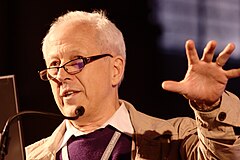George Ellis
 George Ellis (2012) | |
| Imię i nazwisko urodzenia | George Francis Rayner Ellis |
|---|---|
| Data i miejsce urodzenia | |
| Zawód, zajęcie | |
| Miejsce zamieszkania | |
| Narodowość | |
| Tytuł naukowy | profesor |
| Alma Mater | |
| Uczelnia | University of Cambridge, University of Cape Town |
| Wydział | Department of Mathematics and Applied Mathematics (University of Cambridge) |
| Wyznanie | |
| Odznaczenia | |
| Strona internetowa | |
George Francis Rayner Ellis (ur. 11 sierpnia 1939 w Johannesburgu) – południowoafrykański naukowiec: fizyk teoretyczny i matematyczny, a także filozof nauki i działacz społeczny[1]; profesor matematyki stosowanej na Uniwersytecie Kapsztadzkim (RPA). Laureat Nagrody Templetona z 2004 roku.
Specjalności Ellisa to teoria względności i grawitacja, w tym kosmologia teoretyczna. Autor ok. 500 artykułów naukowych i kilku książek, w tym – wspólnie ze Stephenem Hawkingiem – The Large scale Structure of Space Time[2] (Wielkoskalowa struktura Wszechświata[a]); aktywny popularyzator zagadnień leżących na pograniczu nauki i religii[3].
Poglądy
Ellis krytykował niektóre spekulacje fizyków jak teorie strun[1] i hipotezy Wieloświata[4], a także popularną wśród naukowców filozofię redukcjonizmu[1]. Bronił też koncepcji wolnej woli, odwołując się do przyczynowości w rozumieniu Arystotelesa[1]. Określał się jako kwakier[1].
Publikacje

G. Ellis opublikował ok. 500 artykułów[5][6] (w tym liczne w najbardziej prestiżowych czasopismach, tj. Nature), np.:
- Cosmological perturbations and the physical meaning of gauge-invariant variables (1992)[7]
- The case for an open Universe (1994)[8]
- Cosmological models (1998)[9]
- APS Schwarzschild black hole lensing (2000)[10]
- Schwarzschild black hole lensing (2000)[11]
- Gravitational lensing by naked singularities (2002)[12]
- The Emergent Universe: inflationary cosmology with no singularity; Classical and Quantum Gravity (2004)[13]
- Physics, complexity and causality (2005)[14]
Uwagi
- ↑ Zobacz np. Wielka Ściana, Pustka (astronomia), Wielka Pustka, Wielki Atraktor.
Przypisy
- ↑ a b c d e John Horgan, Physicist George Ellis Knocks Physicists for Knocking Philosophy, Falsification, Free Will, Scientific American, scientificamerican.com, 22 lipca 2014 [dostęp 2022-01-11].
- ↑ Stephen Hawking, George Ellis: The Large Scale Structure of Spacetime. Londyn: Cambridge University Press; Monographs on Mathematical Physic, 1973. ISBN 0-521-09906-4.
- ↑ Dr George Ellis. [w:] Counterbalance; Biography [on-line]. www.counterbalance.org. [dostęp 2011-07-10]. (ang.).
- ↑
 George F.R. Ellis, Does the Multiverse Really Exist?, Scientific American, scientificamerican.com, sierpień 2011 [dostęp 2022-01-11].
George F.R. Ellis, Does the Multiverse Really Exist?, Scientific American, scientificamerican.com, sierpień 2011 [dostęp 2022-01-11]. - ↑ Wykaz publikacji Georga Ellisa. [w:] Google Scholar [on-line]. [dostęp 2017-03-25].
- ↑ Wykaz 93 publikacji Georga Ellisa. [w:] Cornell University Library [on-line]. arxiv.org. [dostęp 2017-01-30]. (ang.).
- ↑ M. Bruni, P.K.S. Dunsby, G.F.R. Ellis. Cosmological perturbations and the physical meaning of gauge-invariant variables. „Astrophysical Journal, Part 1”. 395 (1), s. 34–53, 1992. ISSN 0004-637X. (ang.).Sprawdź autora:2.
- ↑ The case for an open Universe. „Nature”. 370, s. 609–615, 25 August 1994. (ang.).
- ↑ George Ellis, Henk van Elst. Cosmological models (Cargèse lectures 1998). „NATO Adv.Study Inst. Ser. C. Math. Phys. Sci.”. 541 (1), s. 1–116, 1999.
- ↑ K.S. Virbhadra, George F.R. Ellis. APS Schwarzschild black hole lensing. „Physical Review D, arXv:astro-ph”, s. 1–10, 19 January 2000. University of Cape Town. (ang.).
- ↑ George F.R. Ellis, K. S. Virbhadra. Schwarzschild black hole lensing. „Phys. Rev. D 62084003”, 2000. (ang.).
- ↑ George F.R. Ellis, K.S. Virbhadra. Gravitational lensing by naked singularities. „Phys. Rev. D 65, 103004”. 65 (10), 2002. The American Physical Society. DOI: 10.1103/PhysRevD.65.103004. (ang.).
- ↑ George F.R. Ellis. The Emergent Universe: inflationary cosmology with no singularity. „arXiv:gr-qc”, 2004. iopscience.iop.org. (ang.).
- ↑ George F.R. Ellis. Physics, complexity and causality. „Nature”. 435, s. 743, 9 June 2005. (ang.).
Linki zewnętrzne
- Publikacje w INSPIRE, the High Energy Physics information system (ang.)
- Wywiad radiowy z kwakrem i kosmologiem George'em Ellisem, laureatem Nagrody Templetona za badania na pograniczu nauki i religii. speakingoffaith.publicradio.org. [zarchiwizowane z tego adresu (2010-07-04)].
 George F.R. Ellis, On the Nature of Cosmology Today (2012 Copernicus Center Lecture), kanał Centrum Kopernika Badań Interdyscyplinarnych na YouTube, 28 stycznia 2013 [dostęp 2022-01-11].
George F.R. Ellis, On the Nature of Cosmology Today (2012 Copernicus Center Lecture), kanał Centrum Kopernika Badań Interdyscyplinarnych na YouTube, 28 stycznia 2013 [dostęp 2022-01-11].
- ISNI: 0000 0001 1698 1956
- ORCID: 0000-0001-8484-0629
- VIAF: 109637661
- LCCN: n79009896
- GND: 170017478
- NDL: 001328104
- BnF: 122989362
- SUDOC: 031850928
- NLA: 35331848
- NKC: uk2006305222
- BNE: XX989957
- NTA: 071045635
- BIBSYS: 2092091
- CiNii: DA02415379
- PLWABN: 9810548879805606
- NUKAT: n01095168
- J9U: 987007320206405171
- LNB: 000263886
- CONOR: 45181027
- LIH: LNB:C7Vv;=Bs
- WorldCat: lccn-n79009896
Media użyte na tej stronie
Autor: Jakob Voß, influenced by original art designed at PLoS, modified by Wikipedia users Nina and Beao, Licencja: CC0
Closed Access logo, derived from PLoS Open Access logo. Alternative version.
WMAP observes the first light of the universe- the afterglow of the Big Bang. This light emerged 380,000 years after the Big Bang. Patterns imprinted on this light encode the events that happened only a tiny fraction of a second after the Big Bang. In turn, the patterns are the seeds of the development of the structures of galaxies we now see billions of years after the Big Bang.
Autor: David Monniaux, Licencja: CC BY-SA 3.0
George Ellis, South African cosmologist
Autor: McOleo, Licencja: CC0
Ribbon bar of the Order of Mapungubwe (RSA)
(c) Col André Kritzinger, CC BY-SA 3.0
Star of South Africa, Member ribbon bar, 35 millimetres wide with a 2 millimetres wide white band, an 11½ millimetres wide dark blue band, a 1 millimetre wide white band and a 2 millimetres wide dark blue band, repeated in reverse order and separated by a 2 millimetres wide white band in the centre.




